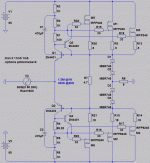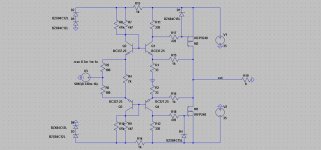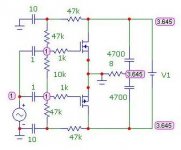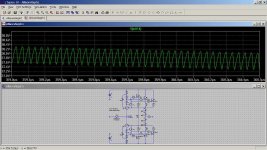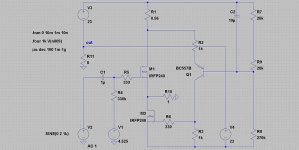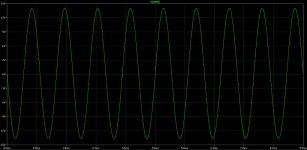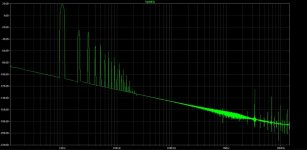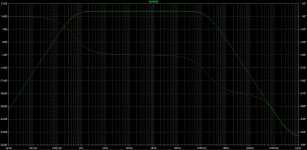Hi,
in the latest edition of the fabulous Linear Audio magazine we have a comprehensive article about a so-called Square-Law Class-A amp written by Ian Hegglun.
I find this design quite remarkable and appealing and I'm musing over building it.
Are there inmates who build this thing? How did it compare soundwise to your stuff?
I freely admit that I didn't really get how the arrangement of the floating supply would ensure the amplifiers gain.
I would love a discussion about that design here.
I did a search and to my surprise I found no thread concerning this amp, should it exist we'd probably don't need another one...
Rüdiger
in the latest edition of the fabulous Linear Audio magazine we have a comprehensive article about a so-called Square-Law Class-A amp written by Ian Hegglun.
I find this design quite remarkable and appealing and I'm musing over building it.
Are there inmates who build this thing? How did it compare soundwise to your stuff?
I freely admit that I didn't really get how the arrangement of the floating supply would ensure the amplifiers gain.
I would love a discussion about that design here.
I did a search and to my surprise I found no thread concerning this amp, should it exist we'd probably don't need another one...
Rüdiger
I have read that artical and to be honnest wasn't impressed at all perfomance is very poor! and heat production still a lot.
Hi Rüdiger, I just got my copy of Linear Audio vol 1 last week, and I too think this concept sounds very interesting.
I am though in the middle of building a Pass F5, and have some of the items to build a F4 also, so I will probably not be ready to participate on building a square-law Class A amp soon.
Did you get any experience, or did you give up the project.
Regard
Arthur.
I am though in the middle of building a Pass F5, and have some of the items to build a F4 also, so I will probably not be ready to participate on building a square-law Class A amp soon.
Did you get any experience, or did you give up the project.
Regard
Arthur.
Schottky Diodes have square law curves, and much lower voltage drop than other
such device (MOSFET diode for example) you could throw in series with a totem to
sense and shape conversion of linear voltage to complimentary square law currents.
A recurring theme in most of my schematics, search my recent threads. I have not
seen what Hegglund has done for comparison, can you point to any drawing of his
that isn't hiding behind a subscription fee?
such device (MOSFET diode for example) you could throw in series with a totem to
sense and shape conversion of linear voltage to complimentary square law currents.
A recurring theme in most of my schematics, search my recent threads. I have not
seen what Hegglund has done for comparison, can you point to any drawing of his
that isn't hiding behind a subscription fee?
Member
Joined 2009
Paid Member
I have not
seen what Hegglund has done for comparison, can you point to any drawing of his
http://perso.orange.fr/francis.audio2/AmpHegglun.doc
Voltage across Schottky stack deliberately insufficient to bias
all four diodes ON at the same time. Yet plenty high enough
to turn on two, and hard... Or all four jammed halfway-on,
riding the curve. Square law curve, if those Schottkys are
sized right...
R7 provides some always-on - do-nothing-reserve current.
Even if a Schottky might turn off, transistors still conduct
this small amount.
all four diodes ON at the same time. Yet plenty high enough
to turn on two, and hard... Or all four jammed halfway-on,
riding the curve. Square law curve, if those Schottkys are
sized right...
R7 provides some always-on - do-nothing-reserve current.
Even if a Schottky might turn off, transistors still conduct
this small amount.
Attachments
Last edited:
Undegenerated complementary (or circlotron) lateral MOSFET outputs are already pretty much D2S to start from, plus they have the desireable feature that the transfer characteristic tends to flatten out to linear at higher currents. Exactly what is required to drive a "square-law" amp into class-B and maintaining transconductance. N-ch tend to have higher gm and lower capacitance, so a gate divider works out nicely as gate stopper and attenuator to get the transfer statically and dynamically complementary. That's IMHO why lateral outputs have something to them, raising interest as can be seen on this forum, lately.
Kenpeter's Allison O/S looks promising, too, when getting all 4 Schottkys a bit conducting at idle, otherwise the voltage transfer has a dead zone a global feedback would have to deal with.
- Klaus
Kenpeter's Allison O/S looks promising, too, when getting all 4 Schottkys a bit conducting at idle, otherwise the voltage transfer has a dead zone a global feedback would have to deal with.
- Klaus
Last edited:
I have read that artical and to be honnest wasn't impressed at all perfomance is very poor! and heat production still a lot.
yes, lots of the heat
but poor? no hf harmonics...
Attachments
Voltage across Schottky stack deliberately insufficient to bias
all four diodes ON at the same time. Yet plenty high enough
to turn on two, and hard... Or all four jammed halfway-on,
riding the curve. Square law curve, if those Schottkys are
sized right...
R7 provides some always-on - do-nothing-reserve current.
Even if a Schottky might turn off, transistors still conduct
this small amount.
Hi Kenpeter
I found simulating your design with LTSpice, that above input voltage 10Vpp is completely unstable, oscilating like mad, could you send asc file for this circuit, I will compare it with mine to find my eventualy mistakes... thanks in advance!
I discovered the folder where this old .asc file had been hiding.
Also tried 10V @ 1KHz and saw no oscillations, thats not really
proof of stability. Any crazy oscillation wouldn't surprise me...
Also tried 10V @ 1KHz and saw no oscillations, thats not really
proof of stability. Any crazy oscillation wouldn't surprise me...
Attachments
Last edited:
> I freely admit that I didn't really get how the arrangement
> of the floating supply would ensure the amplifiers gain.
Square law stuff aside, the gain comes from the fact it is
a common source output. I built this and it works as
it simulates:
Hi
I built this: http://www.diyaudio.com/forums/atta...69-tcj-evolve-simply-good-amps-idea-first.pdf it is working good.
Any crazy oscillation wouldn't surprise me...
Hi Kenpeter,
your models ale different, but set start time 5ms, end 8ms, timestep 1n you will see...
Attachments
Last edited:
square law behavior
Hi, I noticed that you changed the topology from common source to voltage follower. Hegglun mentions this as a means to reduce the output resistance, and also avoid using the floating power supply. This will require a more traditional gain stage (VAS).
Does the voltage follower configuration in your circuit effect the square law behavior?
/Mason
I discovered the folder where this old .asc file had been hiding.
Hi, I noticed that you changed the topology from common source to voltage follower. Hegglun mentions this as a means to reduce the output resistance, and also avoid using the floating power supply. This will require a more traditional gain stage (VAS).
Does the voltage follower configuration in your circuit effect the square law behavior?
/Mason
Why did you choose to omit the shunt stage? How does it sound?Hi I built this: http://www.diyaudio.com/forums/atta...69-tcj-evolve-simply-good-amps-idea-first.pdf it is working good.
/Mason
Why did you choose to omit the shunt stage? How does it sound? /Mason
for simplicity,
sound is "quiet", completely different than from "conventional" amps, it comes like "from away" but every part of frequency range is present.
It needs emmiter/source folower or low zout preamp.
for simplicity
Pictures? I'm may be interested in building a version of this (square law) amp, but with voltage follower.
current amp wins
 ... and I know the secret of incedible sound from this simple circuit...
... and I know the secret of incedible sound from this simple circuit...
it is V to I converter
now you have only to damp peak resonants of your speakers/crossovers
> I freely admit that I didn't really get how the arrangement
> of the floating supply would ensure the amplifiers gain.
Square law stuff aside, the gain comes from the fact it is
a common source output. I built this and it works as
it simulates:
 ... and I know the secret of incedible sound from this simple circuit...
... and I know the secret of incedible sound from this simple circuit...
it is V to I converter

now you have only to damp peak resonants of your speakers/crossovers

new idea
more
attached files show the potential of new amp...
the idea comes from John Broskie and his TCJ Moskido I-out More Current-Output Amplifiers
more
attached files show the potential of new amp...
the idea comes from John Broskie and his TCJ Moskido I-out More Current-Output Amplifiers
Attachments
- Status
- Not open for further replies.
- Home
- Amplifiers
- Solid State
- Square Law Class A Amps
